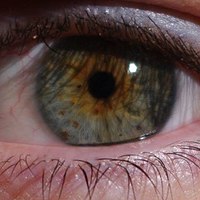Central Heterochromia | Yes, central heterochromia is rare. Due to this rarity of central heterochromia, the people with this disorder appear to be unique, and noticeable. In central heterochromia, people have different color near the border of the pupils. But i never really bothered to thoroughly look at the eyes. This trait usually involves both eyes, with two separate colors appearing in each eye instead of one.
Due to this rarity of central heterochromia, the people with this disorder appear to be unique, and noticeable. Central heterochromia is when the inner ring of the iris — the eye color closest to your pupil — is a different color than the outer ring, along the edge of your iris. The real eye color will always be on the outer rim of the iris. Central heterochromia in particular is caused when the center of the iris looks gold and the outer iris is blue. It may be inherited, or caused by genetic mosaicism, chimerism, disease, or injury.

Central heterochromia is almost always harmless when you're born with it. Eye color is a result of melanin deposits in the iris, which is the part of the. Central heterochromia is a very rare condition affecting less than 1% people in the world. It occurs in humans and certain breeds of. This is where the term 'cat eyes' is derived. This trait usually involves both eyes, with two separate colors appearing in each eye instead of one. So, let us try to learn in detail about this condition. Heterochromia is determined by the production, delivery, and concentration of melanin (a pigment). Yes, central heterochromia is rare. Central heterochromia causes a color abnormality that looks like it stems from the pupil at the center of the eyes, like cat eyes. Heterochromia is a variation in coloration. It may be inherited, or caused by genetic mosaicism, chimerism, disease, or injury. More images for central heterochromia »
A person with central heterochromia may experience shade of gold around the border of the pupil in the center of the iris. Central heterochromia is almost always harmless when you're born with it. Central heterochromia causes a color abnormality that looks like it stems from the pupil at the center of the eyes, like cat eyes. This is where the term 'cat eyes' is derived. An example is a blue center with a gold outer color or border.

The term is most often used to describe color differences of the iris, but can also be applied to color variation of hair or skin. Eye color is a result of melanin deposits in the iris, which is the part of the. Central heterochromia is almost always harmless when you're born with it. But i never really bothered to thoroughly look at the eyes. Due to an uneven distribution of melanin, the outer ring will almost always be blue or green. Rather than have one distinct eye color, people with central heterochromia have a different color near the border of their pupils. It may be inherited, or caused by genetic mosaicism, chimerism, disease, or injury. The rest of the iris, on the other hand, is in another color. An example is a blue center with a gold outer color or border. Sep 12, 2017 · central heterochromia refers to a combination of colors in one eye, and occurs due to uneven distribution of melanin. May 06, 2021 · central heterochromia, in particular, is characterized by differences in pigmentation in the same eyes. In central heterochromia, people have different color near the border of the pupils. This trait usually involves both eyes, with two separate colors appearing in each eye instead of one.
Yes, central heterochromia is rare. Central heterochromia in particular is caused when the center of the iris looks gold and the outer iris is blue. Due to this rarity of central heterochromia, the people with this disorder appear to be unique, and noticeable. Sep 12, 2017 · central heterochromia refers to a combination of colors in one eye, and occurs due to uneven distribution of melanin. It occurs in humans and certain breeds of.

In central heterochromia, people have different color near the border of the pupils. This trait usually involves both eyes, with two separate colors appearing in each eye instead of one. Yes, central heterochromia is rare. A person with this condition may. The real eye color will always be on the outer rim of the iris. Due to this rarity of central heterochromia, the people with this disorder appear to be unique, and noticeable. It occurs in humans and certain breeds of. So, let us try to learn in detail about this condition. A person with central heterochromia may experience shade of gold around the border of the pupil in the center of the iris. More images for central heterochromia » Rather than have one distinct eye color, people with central heterochromia have a different color near the border of their pupils. Eye color is a result of melanin deposits in the iris, which is the part of the. This is where the term 'cat eyes' is derived.
Central heterochromia in particular is caused when the center of the iris looks gold and the outer iris is blue central. Central heterochromia is a very rare condition affecting less than 1% people in the world.
Central Heterochromia! An example is a blue center with a gold outer color or border.
0 comments:
Post a Comment